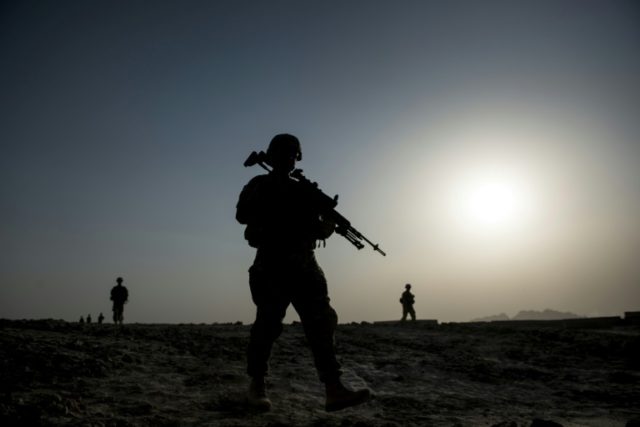WASHINGTON, DC — A potential U.S.-Taliban peace deal “will likely” fail to prevent Afghanistan from grappling with terrorists and descending into a “narco-state,” the U.S. Special Inspector General for Afghanistan Reconstruction (SIGAR), a watchdog agency, declared in a report issued Thursday.
SIGAR chief John Sopko released the agency’s High-Risk List report, which covers threats to America’s multi-billion dollar nation-building efforts, at a Center for Strategic and International Studies (CSIS) event.
The report declares:
With or without a peace settlement, Afghanistan will likely continue to grapple with multiple violent-extremist organizations, who threaten Afghanistan and the international community …With or without a peace agreement, Afghanistan runs the risk of becoming a ‘narco-state’ and has already been described as such by former officials from the U.S. government and international organizations.
According to the Pentagon, Afghanistan is still home to the “highest regional concentration of terrorist groups in the world.”
SIGAR cast doubt on whether or not the Taliban and Afghanistan as a whole will ever end its involvement in the opium trade, which serves as a major source of funding for both.
Citing the United Nations, the watchdog agency reveals:
In 2017, the poppy crop generated approximately $1.4 billion for Afghan farmers, plus billions more for refiners and traffickers, amounting to the equivalent of 20% to 32% of Afghanistan’s gross domestic product—a share about the size of the country’s entire licit agricultural sector and far exceeding licit exports of goods and services in 2016. A peace agreement is unlikely to change that dynamic.
The High-Risk List report identifies serious threats to America’s $132 billion reconstruction effort, including widespread insecurity, underdeveloped civil policing capabilities, endemic corruption, sluggish economic growth, the illicit narcotics trade, threats to women’s right, the challenge of reintegrating about 60,000 Taliban fighters into society and the country’s U.S.-backed security forces, and restricted oversight.
The report points out:
While an equitable and sustainable peace agreement in Afghanistan could end much of the violence that presents the greatest threat to the reconstruction effort, a peace agreement may bring its own set of challenges to sustaining the gains that the United States, its Coalition partners, and the Afghan government have achieved over that time.
For example, a failure to successfully reintegrate Taliban fighters and their families into Afghan society, a failure to improve civil policing, and a failure to ensure effective oversight of continuing foreign financial assistance could each undermine the sustainability of any peace agreement that might be reached.
SIGAR notes that a peace deal may ultimately pose risks to the U.S.-funded reconstruction effort, including:
- The capability and effective use of Afghan security forces, particularly for counterterrorism operations.
- Protection of human rights, including the rights of Afghan women.
- Securing democratic governance processes and upholding the rule of law.
- Suppressing corruption.
- Countering the narcotics trade and promoting alternative livelihoods for farmers.
- Promoting economic growth and development.
- Oversight of and accountability for U.S. funds provided directly to the Afghan government or routed to it via multilateral trust funds.
- Sustainability of U.S.-funded institutions, programs, and property provided in Afghanistan.
Although the U.S. has devoted over $80 billion, the majority (about 65 percent) of reconstruction funding, to the development of the Afghan National Defense and Security Forces (ANDSF), they continue to suffer from capability lapses that hinder the effectiveness and readiness of the forces and may undermine the rule of law after a peace pact, SIGAR determines.
The ANDSF, which includes military and police units, are also unable to operate independent of U.S. military assistance, Sopko indicated at the CSIS event.
SIGAR reveals in the report:
Throughout the reconstruction effort, the United States has placed more emphasis on reconstructing the Afghan National Army (ANA) than on the Afghan National Police (ANP). In the event of a peace settlement, there is no comprehensive strategy for a competent civil police force backed by the rule of law. Current ANP sustainment costs are well beyond the Afghan government’s ability to fund and will require continued foreign assistance well into the future.
Echoing comments by Afghan President Ashraf Ghani in early 2018, the report notes that Afghanistan would collapse without international funding, which along with the opium trade are the main drivers of the war-ravaged country’s economy.
SIGAR notes:
The ANDSF will also continue to be constrained by capability and sustainability challenges. In a post-settlement environment, depending on the terms of an agreement, there may also be the challenge of integrating former Taliban fighters into the national security forces and society. …These issues could become more acute should international financial and military support decline sharply before, during, or after peace talks between the Afghan government and the Taliban.
In recent months, U.S. President Donald Trump’s administration has boosted its efforts to achieve peace with the Taliban. The Trump administration has made the reconciliation of Kabul and the Afghan government the primary goal of its strategy to end the war.

COMMENTS
Please let us know if you're having issues with commenting.